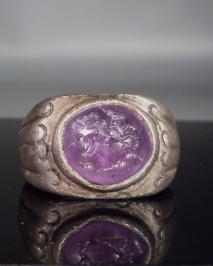J007
Roman silver ring with amethyst intaglio.
1st-2nd century AD
Width 2.4 cm (0.7 in.), ring size 15
Perfect.
Sold
The oval cabochon intaglio depicts a victorious warrior on a horse, spearing his fallen defeated enemy.
This image of a victorious warrior has a long founded tradition in art:
The figure of Alexander the Great was often depicted as a victorious warrior on horseback, spearing the fallen enemy.
In later periods this prototype came to symbolize the figure of King Solomon spearing Lilith (or a representation of evil) in Jewish seals. In Christian depictions the concept of the holy rider was applied to portrayals of different figures, such as St. George.
The figures are depicted in fine style, finely engraved in the gemstone, with attention to detail.
The intaglio, in fine purple color, is originally set in the silver ring, decorated with an engraved deign.
For depictions of Alexander the Great see:
Cf. The National Archaeological Museum of Naples, 1996, figs. 144 (mosaic), 218 (bronze statuette).
For later Jewish examples see:
Goodenough, E. R., 1953, nos. 146-150.
The National Archaeological Museum of Naples, text by Stefano De Caro, Electa Napoli, 1996
Goodenough, E. R., Jewish Symbols in the Graeco-Roman Period, Vol. II-III, Toronto, 1953
Back to top

|
|
 Click on any image to enlarge it.
Click on any image to enlarge it.
 
|
